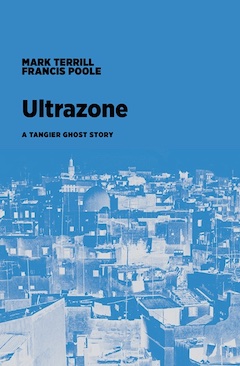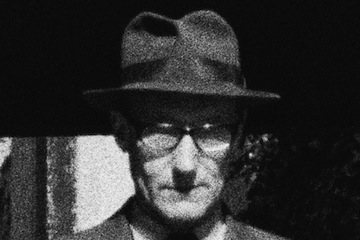UPDATE: Ultrazone has been published and is now available here.
William Burroughs is not around anymore. He died in 1997. But his ghost definitely is. It has returned to Tangier in Ultrazone, a moody yet drole forthcoming novel.

You should know that Burroughs believed he was under “the constant threat of possession” by an invader termed the Ugly Spirit and that he regarded his writing as a lifelong effort to break its hold on him. You should also know that Ultrazone — written by Francis Poole and Mark Terrill — involves a fedora that Burroughs famously wore, or rather a missing fedora, which serves the plot as a MacGuffin. What’s more, the novel’s mixture of fact and fiction gives it the authority of a well-researched document nested within an exotic, fully imagined world. As the novel opens . . .
It was that time of day when the length of a man’s shadow is the same as his height, and in the cemetery of the Anglican Church of St. Andrew in Tangier, Morocco, there’s one single shadow that always falls in the wrong direction. It’s the shadow of Walter Harris, usually wearing one of the many Riffian tribal disguises he had worn when alive. Harris had lived in Tangier for many years as a correspondent for The Times and as a member of M16, the British foreign secret service. A world traveler, an arms dealer, a colorful, gay expatriate author shrouded in mystery and intrigue; in many ways Harris was the ur-Tangerino, a prototype for the many characters that would come to populate Tangier in the years to come.
The ghosts of Ultrazone who shadow the living through the alleys of Tangier are not only intimately alive, they are as vivid as Joyce’s ruminating Dubliners in a tale as rich as anything by Poe. It’s an unbeatable combination.
Harris had died in Malta in 1933 at the age of 66 and his body was returned to Tangier and buried in the St. Andrew’s cemetery. […] A simple and elegant headstone in the form of a miniature Moorish façade sheltered by a projecting roof of green tiles was later erected over Walter Harris’ grave. Since then his ghost had reportedly been seen many times at night moving through the churchyard in the leafy shadows cast by the full moon, and sometimes even in broad daylight. His ghost was a restless one, perhaps anxious to get back to Malta, but unable to do so as long as his remains were interred in Tangier. Moustapha, the cemetery watchman, although relatively well-versed in Moroccan black magic, didn’t know the appropriate spell for getting rid of the ghost of the Englishman. Having been brought up as a Muslim, Moustapha was taught that ghosts as such did not exist, only djinns, supernatural creatures who inhabit an unseen world in dimensions beyond the visible universe of humans. Like human beings, djinns can be good, evil or neutrally benevolent, and hence have free will like humans and unlike angels. But after his many years as watchman in the cemetery, Moustapha had come to believe that ghosts existed as well, often haunting a particular locale, and thus becoming a source of continual annoyance, as was the case with the ghost of Walter Harris. There was a café not far from the cemetery where an old sorcerer with a lazy eye could usually be found smoking kif. On several occasions Moustapha had seen him in the cemetery picking datura flowers and other strange plants. Perhaps it was time to pay him a visit.
And so the gathering of apparitions begins.

